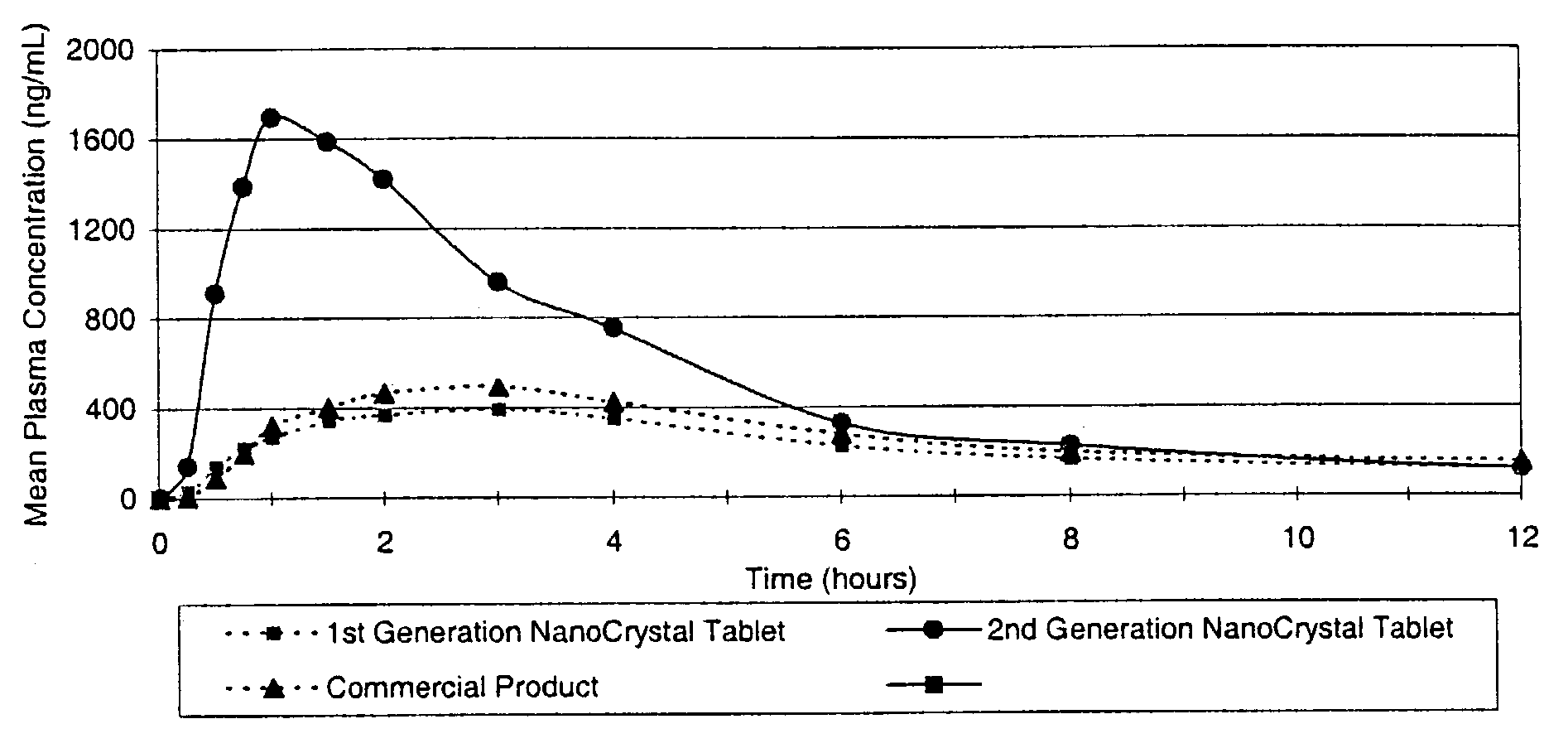In vitro methods for evaluating the in vivo effectiveness of dosage forms of microparticulate of nanoparticulate active agent compositions
a nanoparticulate and active agent technology, applied in the field of in vitro methods for evaluating the in vivo effectiveness of nanoparticulate active agent compositions, can solve the problems of low bioavailability of administered active agents, inability to achieve pharmaceutical activity, and decrease the sensitivity of analytical tests, so as to facilitate rapid and complete dissolution of active pharmaceutical agents
- Summary
- Abstract
- Description
- Claims
- Application Information
AI Technical Summary
Benefits of technology
Problems solved by technology
Method used
Image
Examples
example 1
[0096]The purpose of this example was to compare the in vivo performance of a conventional solid dose microparticulate active agent, a first generation solid dose nanoparticulate active agent, and a second generation solid dose nanoparticulate active agent developed using the redispersibility methods of the invention. The active agent is poorly water-soluble.
[0097]Human volunteers were orally administered a single 200-mg dose of a conventional solid dose microparticulate active agent, a first generation solid dose nanoparticulate active agent, and a second generation solid dose nanoparticulate active agent. FIG. 1 shows the mean pharmacokinetic profiles of each dosage form following administration. Greater plasma levels of active agent correspond to greater bioavailability of administered active agent.
[0098]Surprisingly, the first generation solid dose nanoparticulate active agent dosage form exhibited minimal, if any, increased bioavailability or time to onset over the conventional...
example 2
[0101]The purpose of this example was to evaluate the redispersibility properties of a solid dose nanoparticulate ketoprofen composition in an electrolyte solution. Ketoprofen, also known as m-benzoylhydratopic acid is a nonsteroidal anti-inflammatory analgesic. The drug is poorly water-soluble.
[0102]A ketoprofen nanoparticulate dispersion was prepared having 5% ketoprofen, 1.% polyvinyl pyrrolidone (PVP) K29 / 32, and 0.2% dioctyl sodium sulfosuccinate (DOSS). The dispersion was prepared using a Dyno®—Mill (Type: KDL; Mfg.: Willy A Bachofen AG, Basel Switzerland) equipped with a 150 cc batch chamber using a 500 μm milling media of type Polymill500® for 2 hrs at 10° C.
[0103]The ketoprofen nanoparticulate dispersion (ketoprofen NCD) was then spray dried with mannitol, with a drug to mannitol ratio of 1:1 using a Büchi Mini Spray Dryer B-191 (Büchi, Switzerland). The redispersibility properties of the spray dried ketoprofen composition in water are shown below in Table 1.
[0104]
TABLE 1Re...
example 3
[0110]The purpose of this example was to evaluate the redispersibility properties of a solid dose nanoparticulate MAP kinase inhibitor composition in electrolyte solutions.
[0111]5% (w / w) of Compound A, a poorly water-soluble MAP kinase inhibitor, 1% Plasdone® S630, and 0.2% DOSS were milled using a Dyno®—Mill (Type: KDL; Mfg.: Willy A Bachofen AG, Basel, Switzerland) equipped with a 150 cc batch chamber using a 500 μm milling media of type Polymill500® for 3 hrs at 10° C. Plasdone® S630 is a random copolymer of vinyl acetate and vinyl pyrrolidone.
[0112]The nanoparticulate MAP kinase inhibitor dispersion (NCD) was then spray dried at a drug to mannitol ratio of 1:1 using a Büchi Mini Spray Dryer B-191 (Büchi, Switzerland). The redispersibility properties of the spray dried MAP kinase inhibitor in electrolyte solutions are shown below in Table 3 and in FIG. 2. A Horiba LA910 particle sizer was used to measure particle size. “Small” particles were defined as those below 1 micron and “l...
PUM
 Login to View More
Login to View More Abstract
Description
Claims
Application Information
 Login to View More
Login to View More - R&D
- Intellectual Property
- Life Sciences
- Materials
- Tech Scout
- Unparalleled Data Quality
- Higher Quality Content
- 60% Fewer Hallucinations
Browse by: Latest US Patents, China's latest patents, Technical Efficacy Thesaurus, Application Domain, Technology Topic, Popular Technical Reports.
© 2025 PatSnap. All rights reserved.Legal|Privacy policy|Modern Slavery Act Transparency Statement|Sitemap|About US| Contact US: help@patsnap.com



